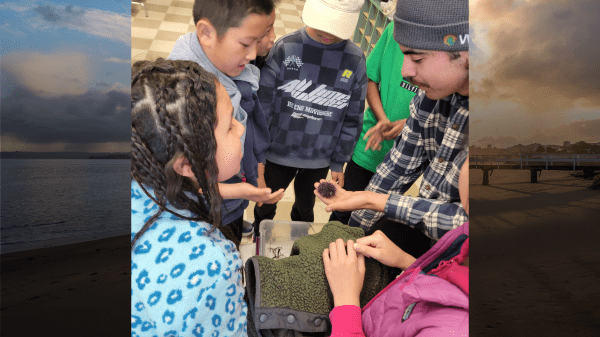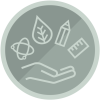Digging Up Interest in Watersheds with Sand Crabs

This blog post was written by Jean Alupay, education program manager, Greater Farallones Association.

Afterschool students from Jean Parker Elementary sort through their findings in hula hoops during a beach exploration at Crissy Field Beach. An educator helps identify the contents of each hula hoop. Photo Credit: Sagit Betser
Picture yourself buried in the sand, peeking your eyes out right at the surface of the sand as turbulent water crashes above you. Suddenly, you see yourself encircled by an enormous plastic wall as you feel the sand beneath you being pulled and emptied on top of the beach. A pair of hands dig the sand around you as they pick you up and cradle you in their palm. You hear the voices of kids calling out to their friends as they crowd around you to get a closer look. You are a sand crab, plucked from the swash zone, and you’ve given a student their first hands-on experience participating in a long-term scientific monitoring program!
Sand crab monitoring is one of the immersive experiences that the Long-Term Monitoring Program and Experiential Training for Students (LiMPETS) conducts with students. LiMPETS is a statewide program of California, and the Greater Farallones Association (GFA) is a key partner that engages students in the San Francisco Bay Area and California North Coast. The goal is to educate, inspire, and empower youth to feel engaged as ocean stewards and increase environmental literacy through immersive coastal learning experiences. The program focuses on middle and high school students, but with support from the eeBLUE 21st CCLC Watershed STEM Education Partnership Grant Program, we expanded and adapted the experience to involve younger students. Specifically, we adapted the curriculum to focus on giving third through fifth grade students from Jean Parker Elementary in San Francisco science enrichment that utilizes all their senses, both in the classroom and in the field.
Beginning February 2025, GFA educators visited 50 third through fifth grade students during their afterschool program. Over three classroom visits, educators discussed:
- The National Marine Sanctuary System and the protected coastal habitats in these students’ “backyard,”
- What a sand crab is and why it is important to the ecosystem, and
- What monitoring is and how scientists, like students, monitor sand crabs.
During each visit, live animals and science tools were brought in to give students experiential opportunities. In addition, students were exposed to different careers in marine science and learned directly from the experts themselves!
During two classroom visits, an educator was joined by a local fisherwoman who shared about her life in two different fishing industries—salmon and crabs. For the crab talk, students observed live crabs, held them, and learned how they are fished sustainably using crab pots. In the salmon lesson, students learned about the life cycle of salmon and observed a dissection to better understand how salmon are adapted to their fresh and saltwater environments.

Students from Jean Parker Elementary crowd around and point out a sand crab they found on the beach. Photo Credit: Sagit Betser

An afterschool student from Jean Parker Elementary asking an educator about his findings on a sandy beach during a field trip to Crissy Field in San Francisco. Photo Credit: Sagit Betser
Following five classroom visits, students were ready for their first field experience! With the guidance of GFA educators and support from teachers and chaperones, students explored Crissy Field Beach, watching the swash zone first-hand and finding sand crabs among many other living and nonliving things on the beach. They even helped clean up the nonliving marine debris. For many underserved students with socio-economic barriers or limited opportunities, participating in LiMPETS is their first time setting foot on a local beach despite living just miles from the ocean. One participating Jean Parker Elementary teacher shared that two students specifically expressed never having been to the beach and that this field trip was their very first time. The students were ecstatic, getting nearly knee-deep in water!
Before and after the LiMPETS program experience, students provided feedback through a grade-specific evaluation. An evaluator analysis showed that 95% of students loved or liked being outside in nature after the program, an 18% increase from before their field experience. Ninety percent thought that participating in LiMPETS made them a little or more interested in protecting the ocean and environment. We hope these experiences create lasting connections with nature and inspire lifelong environmental stewardship long after the sand crabs collected are returned to the sea.
NAAEE, in collaboration with NOAA and supported by the U.S. Department of Education, is working with twelve environmental education organizations to offer engaging after-school watershed-focused STEM (science, technology, engineering, and mathematics) programs. The eeBLUE 21st Century Community Learning Centers Watershed STEM Education Partnership Grants, administered by NAAEE and running from 2024–2025, support environmental education organizations collaborating directly with 21st CCLC sites. These sites play a crucial role in designing and implementing locally relevant, out-of-school-time programs that develop students' environmental literacy and leadership skills as they improve their communities. These grants support programming for local Nita M. Lowey 21st Century Community Learning Centers (21st CCLC) sites and their students, many of whom live in underserved areas. The 12 selected projects serve 11 states, ranging from Hawai’i to Maine.


